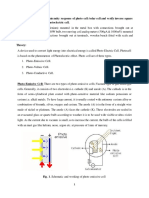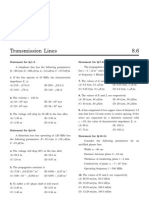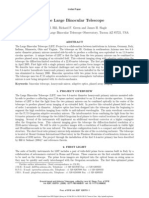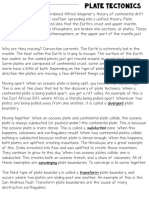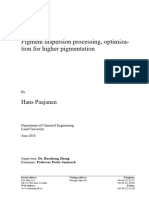Adaptive Optics in Ground Based Telescopes PPT-EnggRoom
Adaptive Optics in Ground Based Telescopes PPT-EnggRoom
Uploaded by
Afdhal KhairiCopyright:
Available Formats
Adaptive Optics in Ground Based Telescopes PPT-EnggRoom
Adaptive Optics in Ground Based Telescopes PPT-EnggRoom
Uploaded by
Afdhal KhairiOriginal Description:
Copyright
Available Formats
Share this document
Did you find this document useful?
Is this content inappropriate?
Copyright:
Available Formats
Adaptive Optics in Ground Based Telescopes PPT-EnggRoom
Adaptive Optics in Ground Based Telescopes PPT-EnggRoom
Uploaded by
Afdhal KhairiCopyright:
Available Formats
Adaptive Optics in Ground Based Telescopes
ABSTRACT
The turbulent mixing of air at different temperatures
continually changes the speed and direction of starlight as it passes
through the atmosphere. It limits the resolution of a telescope and
makes the images seen through it, blurred. Adaptive optics is a new
technology which in effect removes this atmospheric tremor and helps
the astronomers see the images through earth based telescopes more
brightly.
www.enggroom.com 1
Adaptive Optics in Ground Based Telescopes
CONTENTS
1. INT!"#$TI!N
%. &'AT I( A"A)TI*+ !)TI$(
,. -A(I$ )IN$I).+
/. -A(I$ 0#N$TI!NA. "IA1A2
3. "+*+.!)2+NT !0 A"A)TI*+ !)TI$(
4. (++IN1 IN0A+"
5. !T'+ (TA(, !T'+ +AT'(
6. 0#T#+ +N'AN$+2+NT(
7. .I2ITATI!N(
18.$!N$.#(I!N
11.+0++N$+(
www.enggroom.com %
Adaptive Optics in Ground Based Telescopes
INTRODUCTION
Adaptive optics is a new technology which is being used
now a days in ground based telescopes to remove atmospheric tremor
and thus provide a clearer and brighter view of stars seen through
ground based telescopes. &ithout using this system, the images
obtained through telescopes on earth are seen to be blurred, which is
caused by the turbulent mixing of air at different temperatures.
Adaptive optics in effect removes this atmospheric tremor.
It brings together the latest in computers, material science, electronic
detectors, and digital control in a system that warps and bends a mirror
in a telescope to counteract, in real time the atmospheric distortion.
The advance promises to let ground based telescopes
reach their fundamental limits of resolution and sensitivity, out
performing space based telescopes and ushering in a new era in optical
astronomy. 0inally, with this technology, it will be possible to see gas9
giant type planets in nearby solar systems in our 2ilky &ay galaxy.
Although about 188 such planets have been discovered in recent years,
all were detected through indirect means, such as the gravitational
effects on their parent stars, and none has actually been detected
directly.
www.enggroom.com ,
Adaptive Optics in Ground Based Telescopes
WHAT IS ADAPTIVE OPTICS ?
Adaptive optics refers to optical systems which adapt to
compensate for optical effects introduced by the medium between the
ob:ect and its image. In theory a telescope;s resolving power is directly
proportional to the diameter of its primary light gathering lens or
mirror. -ut in practice , images from large telescopes are blurred to a
resolution no better than would be seen through a %8 cm aperture with
no atmospheric blurring. At scientifically important infrared
wavelengths, atmospheric turbulence degrades resolution by at least a
factor of 18.
(pace telescopes avoid problems with the atmosphere, but
they are enormously expensive and the limit on aperture si<e of
telescopes is =uite restrictive. The 'ubble (pace telescope, the world;s
largest telescope in orbit , has an aperture of only %./ metres, while
terrestrial telescopes can have a diameter four times that si<e.
In order to avoid atmospheric aberration, one can turn to
larger telescopes on the ground, which have been e=uipped with
A"A)TI*+ !)TI$( system. &ith this setup, the image =uality that
can be recovered is close to that the telescope would deliver if it were
in space. Images obtained from the adaptive optics system on the 4.3 m
diameter telescope, called the 22T telescope illustrate the impact.
www.enggroom.com /
Adaptive Optics in Ground Based Telescopes
Two images of a small region in the vicinity of the middle
star in !rion;s sword9 a cluster of young stars were taken. The images
show a close grouping of four stars. In the conventional blurred image,
its not possible to make out more than two stars. &ith the adaptive
optics on the other hand, sharpness improves by a factor of 1,, making
it clear that the fainter star is ,in fact a binary > two stars close together
>and a fourth fainter member of the group appears that was previously
undetected.
www.enggroom.com 3
Adaptive Optics in Ground Based Telescopes
www.enggroom.com 4
Adaptive Optics in Ground Based Telescopes
BASIC PRINCIPLE
As light from a distant star reaches the earth, it is
made up of plane waves that , in the last microseconds of their :ourney
to the telescope, become badly distorted by atmospheric turbulence. An
adaptive optics system reflattens the wave fronts by reflecting the light
of a deformable mirror whose shape is changed in real time to
introduce an e=ual but opposite distortion.
The information on how to distort the mirror comes
from a wave front sensor, an instrument that measures optical
aberration imposed by the atmosphere on light from a star. A fast
computer converts the signals coming from the wave front sensor into
drive signals for the deformable mirror. The whole cycle operates at a
never ending cycle of measurement and correction, at typical speeds of
1888 updates per second.
After the light reflects of the deformable mirror, a
beam splitter sends part of the light to a camera that will capture the
high resolution image produced by the adaptive optics.
www.enggroom.com 5
Adaptive Optics in Ground Based Telescopes
BASIC FUNCTIONAL DIAGRAM
www.enggroom.com 6
Adaptive Optics in Ground Based Telescopes
DEVELOPMENT OF ADAPTIVE OPTICS
In the early 1758;s the #.( department of defense
began supporting an effort to develop a real9time image correction
system to obtain sharp pictures of (oviet satellites. The first high
resolution images were obtained in 176%. over the next ten years, both
military and astronomical communities vigorously advanced the state
of the art . A new wavefront sensor and a new deformable mirror that
were successfully tested. .ater on, pioneering work by the #.( air
force showed that an adaptive optics system could operate very
efficiently using a laser to create an artificial star in the sky as the wave
front reference. This information was a boost to the astronomers, and
adaptive optics are now in regular use in large telescopes all over the
world.
The +uropean southern observatory, based in
1ermany operates a very large telescope. It consists of four separate 69
metre telescopes that can be optically linked to form one giant
telescope. At present :ust one of them is fitted with adaptive optics
system, feeding a near >infrared camera and low resolution
spectrograph, but plans for the eventual addition of adaptive optics to
all four.
!ne other telescope bears special mention? the three
meter (hane telescope of the .ick !bservatory, on 2t 'amilton. It;s
the only telescope that doesn;t need to rely on light from a star to
provide information on atmospheric distortion. Instead it uses a laser
www.enggroom.com 7
Adaptive Optics in Ground Based Telescopes
beam pro:ected into the sky, tuned to 367 nm, the same wavelength as
sodium vapour lamps. This laser beam excites a layer of sodium atoms
73 km above the earth;s surface left by meteorites.
These atoms scatter light back to the telescope,
creating what looks like a glowing spot in the sky. $urrently the lasers
needed to do this :ob are expensive and difficult to maintain, but efforts
are being made to change that. The &.2 @eck !bservatory will soon
begin operation with a laser guide star, and as the laser becomes
readily available, many other telescope pro:ects will adopt the laser
guide star approach to adaptive optics.
www.enggroom.com 18
Adaptive Optics in Ground Based Telescopes
SEEING INFRARED
Astronomers are mainly interested in the near and
mid infrared region. A modern telescope consists of a large concave
primary mirror, designed to capture a lot of light, and a smaller,
secondary mirror that focuses the light onto a detector. In the infrared,
the hardware of adaptive optics consists of an existing telescope,
complete with its primary and secondary mirrors, and adds a separate
box of optics, including the deformable mirror, to perform the
atmospheric compensation.
This approach has two main disadvantages. !ne
is that each additional optical surface beam train absorbs some of the
light from the target ob:ect in the sky, making the ob:ect appear fainter.
Also it emits light by virtue of its warmth, introducing thermal noise,
further degrading the astronomers, ability to detect faint ob:ects.
In order to avoid this, at the 22T, a separate
secondary mirror has been built which does double dutyA it acts as a
normal secondary by focusing star light onto the high resolution
imaging system, but it is also deformable, top act as the adaptive
optical wavefront corrector.
www.enggroom.com 11
Adaptive Optics in Ground Based Telescopes
Thus starlight coming from the telescope is
already fully corrected and focuses down to a high resolution image,
with greater intensity and thermal background an order of magnitude
lower than what a telescope e=uipped with conventional adaptive
optics could deliver.
-ut the scientific advantages of wave front correction at
the telescope;s secondary faces enormous technical challenges, the
most important of them being how to make a piece of glass whose
surface could be precisely controlled and shaped to within a few
nanometers a thousand times a second.
In order to overcome this, expertise of astronomers was
called for. To make the adaptive secondary mirror, two pieces of glass
with a very low coefficient of thermal expansion were first ground with
matching spherical shapes. They were then bonded together with a 188
micrometre thick later of pitch, a li=uid that is very viscous at room
temperature.
This arrangement holds the two pieces of glass like a
single rigid body as the convex surface is ground down to a
membrane :ust % mm thick. The desired optical surface, a hyperboloid
was then polished into the membrane with the same techni=ue used for
the large primary mirrors. To release the membrane, the whole
assembly was baked to 1%8 degree celsius, melting the pitch and
allowing the membrane to slide off the front convex surface of the
membrane, coated with aluminium, becomes the deformable mirror.
www.enggroom.com 1%
Adaptive Optics in Ground Based Telescopes
The second difficulty, controlling the shape of
the membrane at high speed and with extremely precision, was later
solved. The problem is that the membrane is very floppy, so that in
trying to push it around to change its shape rapidly, it rings in hundreds
of resonant modes. #nchecked, these resonances would make it
possible to control the rapid changes in the shape of the mirror. but by
placing the membrane :ust /8 micrometre away from a second, rigid
piece of called the shape reference plate, it was discovered that the
thin layer of air between them become so viscous that all the
resonances are damped out.
In the fully assembled mirror, the membrane;s shape is
controlled by ,,4 voice9coil actuators, like miniature loud speakers.
They couple to ,,4 rare9earth magnets glued to the back of the
membrane. The separation between the copper coils and the magnets is
8.% mm. A current through each coil generates a variable magnetic
field, which exerts a force on the corresponding permanent magnet and
moves the glass membrane.
#ni=ue to this deformable mirror are capacitive position
sensors that measure the mirror;s local position. The capacitors are
chromium rings deposited on the front surface of the reference plate
around each of the ,,4 actuators. The capacitance between each
chromium ring and an aluminiium coating on the back of the
deformable mirror across the /8 micrometre air gap is about 43 p0. A
s=uare wave voltage applied across the capacitors allows them to be
www.enggroom.com 1,
Adaptive Optics in Ground Based Telescopes
read at /8 k'<, giving a measure of the local position of the membrane
with respect to the rigid reference plate, accurate to , nm.
In the normal orientation when installed in the telescope,
the flexible membrane is at the bottom. Above that is rigid reference
plate, 38 nm thick, pierced by ,,4 holes through which poke the
actuators. The coils of the actuators are mounted on the ends of 18 cm
long aluminium fingers that conduct heat to an aluminium cold plate,
two machined pieces glued and bolted together.
$ooling fluid circulates through grooves milled into the
lower plates. The fluid is a mixture of distilled water and methanol.
This solution won;t free<e even at cold temperatures. Above the cold
plate are three electronic units containing 146 "()s. +ach "() is
responsible for controlling two actuators, reading the capacitive
sensors and updating the drive currents in the coils to keep the mirror
in right shape. This makes it resistive to vibrations, wind buffeting and
changes in the direction of gravity. It has been shown that the 22T
adaptive optics system holds its shape to an astonishing 18nm against
winds at speeds of about 38 kmph.
Thus with the difficulties in building an adaptive
secondary mirror overcome, we will be able to see in detail a
mechanism by which stars of varying masses are distributed through
the galaxy.
www.enggroom.com 1/
Adaptive Optics in Ground Based Telescopes
$anceling distortion in the 22T;s adaptive optics
system, light from the primary mirror, distorted by the atmosphere,
reflects from the adaptive secondary mirror that is deformed to correct
for the distortion. A beam splitter shunts some light from this mirror to
a wavefront sensor. The sensor;s output goes to an array of digital
signal processors in a control computer, which calculates how much
and where to deform the mirror to compensate for the atmospheric
www.enggroom.com 13
Adaptive Optics in Ground Based Telescopes
distortion. The corrected light passes through a lens that focuses it into
a high9resolution image.
www.enggroom.com 14
Adaptive Optics in Ground Based Telescopes
OTHER STARS, OTHER EARTHS
)erhaps the most exciting scientific program to benefit
from the new approach to adaptive optics will be to look at Bupiter like
planets orbiting other stars. oughly 188 such stars have been found
out through observations of the effects on the motion of their parent
stars, but none has ever be seen by direct imaging. It happens because
they are extraordinarily faint and to compound the problem, they are
right next to something that is enormously brighter.
&e can learn about the environments in which the planets
form. 2easurements of the planet;s brightness at different wavelengths
will tell us about the planet;s temperature and chemical composition
and whether the system has conditions to support life. !bservations in
the thermal infrared region of the spectrum will be particularly
valuable because many simple organic molecules like methane emit
strongly there. &e can also exercise many of the observational
techni=ues and new technologies re=uired to eventually find and study
earth9like planets.
The big challenge here is to distinguish a planet;s light
from that of its parent star. In the visible range, where planets shine by
reflecting starlight, contrast ratios between a planet and its star can be
extremely large.
www.enggroom.com 15
Adaptive Optics in Ground Based Telescopes
Counger giant planets, less than a billion years old or so,
still retain much of the heat created by their evolution out of the
primeval matter from which their solar systems were formed, and
radiate strongly in the thermal infrared. -ut most planetary systems,
like our own are much older. They will have cooled and will no longer
glow in the thermal infrared as they once did.
A further complication occurs when trying to capture an
image of the stellar system at the telescope. egions of the image close
to the star, where its planets may be found, are swamped by a halo of
starlight scattered by earth;s atmosphere. The halo adds photon noise
orders of magnitude greater than the tiny planetary signal. To hope of
finding the planet, we must rely on adaptive optics to suppress the halo
as much as possible. The very low thermal background radiation
coming from the 22T adaptive optics system provides a crucial
advantage by reducing the photon noise against which the planet must
be seen.
The stellar halo can also be suppressed still further
through destructive interference, using a techni=ue called nulling
interferometry. In this procedure, the two images from two telescopes
are overlapped exactly and in such a way that at the location of the star,
the crests in the light waves from one telescope fall on the troughs of
the waves from the other, canceling each other out. Thus a dark image
is formed where, before, the bright stellar image was found.
www.enggroom.com 16
Adaptive Optics in Ground Based Telescopes
The principle of conservation of energy re=uires that the
starlight not be destroyed, and indeed it appears at a second output of
the nulling interferometer. It is removed, though, in the crucial region
closest to the star we would expect to look for planets. )lanetary
images will therefore be seen with greatly improved contrast.
www.enggroom.com 17
Adaptive Optics in Ground Based Telescopes
FUTURE ENHANCEMENTS
As we continue to develop this program, further
improvements in our instrumentation will allow us to see fainter
ob:ects. The next ma:or step will be the completion of the .arge
-inocular telescope, combining two 6./ m primary mirrors on a single
mount , each e=uipped with its own secondary mirror. The corrected
light from the two halves of the telescope will then be brought together
in the centre in a new nulling interferometer which is being built.
)redictions of the instrument;s sensitivity show that we
can expect direct detection of several planets already known to exist
like #rsae 2a:oris, and v Andromedae. 2any others are likely to be
discovered for the first time because of the instrument;s ability to
explore a much greater region of space around each star than is
possible with today;s indirect detection methods.
www.enggroom.com %8
Adaptive Optics in Ground Based Telescopes
LIMITATIONS
!nly infrared is currently practical.
(mall isoplanatic patch Darea that needs researchE
-ecause the isoplanatic patch for the atmosphere is so
small, only a tiny fraction of the sky will be near suitably bright stars
that can serve as reference. -ut this has now been overcome now by
using lasers to excite sodium atoms in the atmosphere, producing an
artificial star that can be placed near any target of interest.
www.enggroom.com %1
Adaptive Optics in Ground Based Telescopes
CONCLUSION
There are many substantial technological challenges in
A!. Among them are the development of fast, very low9noise detectors
in order to be able to correct with fainter reference starsA high9power
reliable F easy to operate sodium lasersA very fast processors
exceeding 187 to 1818 operations per secondA deformable mirrors with
bandwidths of several kilohert< and with thousands of actuators, and
large secondary adaptive mirrors. The latter are especially interesting at
thermal wavelengths, where any additional mirror raises the already
huge thermal background seen by the instruments.
There are A! systems in the Infrared routinely achieving
near diffraction9limited images and spectroscopic data cubes on large
telescopes up to the present generation of 6918 m diameter. (ignificant
corrections have been obtained in the visible in exceptionally good
seeing conditions
2any recent astronomical discoveries can be directly
attributed to new optical observation capabilities. &ith the new
generation of *ery .arge Telescopes entering into operation, the role
of A! systems is extremely important.
&ith this capability, their huge light9gathering along with
the ability to resolve small details, both spatially and spectrally, has the
potential to bring ma:or advances in ground9based astronomy in the
new decade. 0urther down the line, the giant optical telescopes of the
future will rely on advanced A! systems for basically all their
observationsA they will have to be incorporated right at the start of the
pro:ects.
www.enggroom.com %%
Adaptive Optics in Ground Based Telescopes
REFERENCES
I+++ (pectrum "ecember %88,
http?GGcaao.as.ari<ona.eduG.
http?GGcfao.ucolick.org
www.seminarsonly.com
www.enggroom.com %,
Adaptive Optics in Ground Based Telescopes
www.enggroom.com %/
You might also like
- VW 50133 en 2021-06Document15 pagesVW 50133 en 2021-06xu zhang100% (1)
- Experimental Determination of The Speed of LightDocument9 pagesExperimental Determination of The Speed of LightAlexRobertsNo ratings yet
- Report HornDocument4 pagesReport HornMohd Razali Baharon100% (2)
- Diffraction GratingDocument5 pagesDiffraction GratingAnthonio MJNo ratings yet
- BraggsLawandX RaydiffractionDocument9 pagesBraggsLawandX RaydiffractionAshton Poovarasu JhonsonNo ratings yet
- Satellite Systems: Ravikiran S. AnandeDocument56 pagesSatellite Systems: Ravikiran S. Anandervanande21No ratings yet
- He Ne LaserDocument6 pagesHe Ne LaserGaurav Kumar TiwariNo ratings yet
- Achromatic Prisms and LensesDocument4 pagesAchromatic Prisms and LensesModyKing99No ratings yet
- Chapter 5 Part 2 Bode PlotDocument45 pagesChapter 5 Part 2 Bode PlotumarNo ratings yet
- Digital InstrumentsDocument65 pagesDigital InstrumentsPramod PathadeNo ratings yet
- Satellite CommunicationDocument74 pagesSatellite CommunicationsuhasNo ratings yet
- Nano SatelliteDocument17 pagesNano SatelliteNiveditaa SinghNo ratings yet
- Optics LensesDocument4 pagesOptics LensesJerry Pui Chaw MinNo ratings yet
- Nanosatellite Communication and MEMS Technology: Project SummaryDocument17 pagesNanosatellite Communication and MEMS Technology: Project Summaryjaennii parkNo ratings yet
- Operational Amplifier Exam QuestionDocument3 pagesOperational Amplifier Exam QuestionKuseswar Prasad100% (1)
- CHAPTER 3 Superposition AnalysisDocument24 pagesCHAPTER 3 Superposition Analysisnurul najwaNo ratings yet
- Fresnel Biprism ExperimentDocument11 pagesFresnel Biprism ExperimentanuragNo ratings yet
- Fresnel BiprismDocument9 pagesFresnel BiprismscirbdujNo ratings yet
- Second Year Syllabus BCT IOE NepalDocument20 pagesSecond Year Syllabus BCT IOE NepalrajeshkecNo ratings yet
- Unit 5 SCDocument91 pagesUnit 5 SCs gopala krishnaNo ratings yet
- Energy Interactions With Earth Surface FeaturesDocument10 pagesEnergy Interactions With Earth Surface FeaturesBernalyn ManaogNo ratings yet
- Wave Guids PDFDocument32 pagesWave Guids PDFlakshman donepudiNo ratings yet
- Experiment 112-8: Grating and Prism SpectrometerDocument6 pagesExperiment 112-8: Grating and Prism SpectrometerTuhinVariaNo ratings yet
- TechnicalPaper OpticsDocument6 pagesTechnicalPaper OpticsDave BelachaNo ratings yet
- Parabolic Dish AntennaDocument4 pagesParabolic Dish AntennaElisha Ndhlovu100% (1)
- Solar CellDocument33 pagesSolar CellSumit BansalNo ratings yet
- Satellite TutorialDocument2 pagesSatellite Tutorialtarunch89100% (1)
- Chapter-4 Optical SourcesDocument67 pagesChapter-4 Optical Sourceslifemlk100% (4)
- Satellite SubsystemDocument15 pagesSatellite Subsystemmtheo20No ratings yet
- Determination of The Speed of Light.Document12 pagesDetermination of The Speed of Light.mohammed1998No ratings yet
- Malus' LawDocument3 pagesMalus' LawJose GalvanNo ratings yet
- Ect401 M2Document15 pagesEct401 M2hrithikNo ratings yet
- Photoelectric EffectDocument7 pagesPhotoelectric Effectpriyanka .SNo ratings yet
- To Determine The Diffraction Using Laser Beam and Find The Grating Element of Diffraction GratingDocument8 pagesTo Determine The Diffraction Using Laser Beam and Find The Grating Element of Diffraction GratingAkanksha YadavNo ratings yet
- Illumination Technology Module 3Document45 pagesIllumination Technology Module 3Viki PrasadNo ratings yet
- 1 Loop AntennasDocument5 pages1 Loop AntennasSilicon SolNo ratings yet
- 50.solar Tracking System For Optimal Power GenerationDocument4 pages50.solar Tracking System For Optimal Power GenerationRavi Teja Varma KunaparajuNo ratings yet
- Thesis MPPTDocument64 pagesThesis MPPTGuichi OmarNo ratings yet
- Semiconductor Energy Gap PDFDocument8 pagesSemiconductor Energy Gap PDFŽąsis Medina100% (1)
- 04 Radar CharacteristicsDocument22 pages04 Radar CharacteristicsAbdullah OmerNo ratings yet
- 9.2 The External Quantum e Ciency: 9. Solar Cell Parameters and Equivalent CircuitDocument3 pages9.2 The External Quantum e Ciency: 9. Solar Cell Parameters and Equivalent CircuithijerNo ratings yet
- Chapter2 PN Junction Diode PDFDocument30 pagesChapter2 PN Junction Diode PDFJ VikasNo ratings yet
- Miller QuestionDocument3 pagesMiller QuestionjohnnyNo ratings yet
- Interferometry PresentationDocument26 pagesInterferometry PresentationbathinsreenivasNo ratings yet
- Adv Survay 2Document21 pagesAdv Survay 2AshenPereraNo ratings yet
- Comunicaciones Satelitales 2da Edicion Timothy Pratt, Charles W. Bostian, Jeremy E. AllnuttDocument143 pagesComunicaciones Satelitales 2da Edicion Timothy Pratt, Charles W. Bostian, Jeremy E. AllnuttAlfa Group0% (1)
- Photometry and Radiometry NumericalsDocument15 pagesPhotometry and Radiometry NumericalsSSA DarsNo ratings yet
- Experiment Photocell6572Document6 pagesExperiment Photocell6572ShubhamNo ratings yet
- Experiment 1Document12 pagesExperiment 1Ashish Meena100% (1)
- Transmission LinesDocument8 pagesTransmission LinesMohammad ShafiquddinNo ratings yet
- Wavelength Routing Testbeds: Presented By, Bibi Mohanan M.Tech, OEC Roll No:7Document30 pagesWavelength Routing Testbeds: Presented By, Bibi Mohanan M.Tech, OEC Roll No:7Bibi Mohanan100% (1)
- Solar Constant, Beam and Diffuse Radiation, Attenuation of Solar RadiationDocument15 pagesSolar Constant, Beam and Diffuse Radiation, Attenuation of Solar RadiationBalajagannath NadarNo ratings yet
- Adaptive OpticsDocument26 pagesAdaptive OpticsPrasanth NaikNo ratings yet
- Marudhar Engineering College: Adaptive OpticsDocument1 pageMarudhar Engineering College: Adaptive OpticsSahuManishNo ratings yet
- Adaptive Optics: Technical Seminar BY SRIKUMARAN .N (1603137)Document7 pagesAdaptive Optics: Technical Seminar BY SRIKUMARAN .N (1603137)SABAPATHINo ratings yet
- OPN Astrophotonics RevisedDocument8 pagesOPN Astrophotonics Revisedlibros bertranNo ratings yet
- Chapter 6Document128 pagesChapter 6teacherangiebyshNo ratings yet
- Our Understanding of Celestial Objects Depends Upon Observations Made From Earth or From Space Near EarthDocument13 pagesOur Understanding of Celestial Objects Depends Upon Observations Made From Earth or From Space Near Earthchristian-dale-lim-1450No ratings yet
- Dispersing Light Structure of A Spectrograph Recording A SpectrumDocument3 pagesDispersing Light Structure of A Spectrograph Recording A SpectrumRahul KumarNo ratings yet
- Large Binocular Telescope 2006Document15 pagesLarge Binocular Telescope 2006王轩No ratings yet
- TelescopesDocument23 pagesTelescopesAryan SaxenaNo ratings yet
- Cooling Coils For Chilled Water For Connection To Circular DuctsDocument4 pagesCooling Coils For Chilled Water For Connection To Circular DuctserreagaaNo ratings yet
- Bioseparation-Crystallization 1Document16 pagesBioseparation-Crystallization 1LCteyNo ratings yet
- MDP4540 Creep Failure SheetDocument2 pagesMDP4540 Creep Failure Sheet154 ahmed ehabNo ratings yet
- NEW DSR (Effective From 01-07-2023)Document1 pageNEW DSR (Effective From 01-07-2023)rahul pardeshiNo ratings yet
- Welding Report - 2020CEC2796Document20 pagesWelding Report - 2020CEC2796Govind Rao AndeNo ratings yet
- Seismic Analysis of Regular and Irregular Multistorey Buildngs Using Staad - ProDocument8 pagesSeismic Analysis of Regular and Irregular Multistorey Buildngs Using Staad - ProInternational Journal of Innovative Science and Research TechnologyNo ratings yet
- Lecture Note Drying May19Document50 pagesLecture Note Drying May19ara_1909No ratings yet
- Copper Migration Induces Discoloration On A Nipdau SurfaceDocument4 pagesCopper Migration Induces Discoloration On A Nipdau SurfaceJames BelciñaNo ratings yet
- SOM Lab Manual PDFDocument31 pagesSOM Lab Manual PDFchetbkNo ratings yet
- Syllabus For Written Test For Management Trainee PostsDocument9 pagesSyllabus For Written Test For Management Trainee PostsSanjeet thakurNo ratings yet
- Tribology QP & Syllabus Vtu PRASHANTHDocument21 pagesTribology QP & Syllabus Vtu PRASHANTHpachieduNo ratings yet
- Bomba de Agua 4" SM20 Manual de ServicioDocument24 pagesBomba de Agua 4" SM20 Manual de ServicioHolman Sánchez OlguínNo ratings yet
- Plate TectonicsDocument2 pagesPlate Tectonicsapi-262768768No ratings yet
- 1583303084585-Final MCQ For Alp (Promotive)Document51 pages1583303084585-Final MCQ For Alp (Promotive)sai creativesNo ratings yet
- Real-Time Bridge Deflection and Vibration Monitoring Using An Integrated Gps/Accelerometer/Pseudolite SystemDocument9 pagesReal-Time Bridge Deflection and Vibration Monitoring Using An Integrated Gps/Accelerometer/Pseudolite Systemcandiselow123No ratings yet
- Strength Classes (BSH) : EN14080:2005 + EN 1194 / DIN 1052 "New" EN 14080:2013Document1 pageStrength Classes (BSH) : EN14080:2005 + EN 1194 / DIN 1052 "New" EN 14080:2013Melo PereiraNo ratings yet
- I-Beam Girder ComputionsDocument10 pagesI-Beam Girder ComputionsMark Christopher Del RosarioNo ratings yet
- Aiats-1 - Assignment - Question PaperDocument35 pagesAiats-1 - Assignment - Question PaperstuakatharsaaNo ratings yet
- Pigment Dispersion Processing Optimization ForDocument61 pagesPigment Dispersion Processing Optimization Forrndsb.aopNo ratings yet
- Qualicoat Specifications 2023 - Master Version - V01Document92 pagesQualicoat Specifications 2023 - Master Version - V01idelcio rochaNo ratings yet
- Photoelectric DevicesDocument10 pagesPhotoelectric DevicesJawad Sandhu0% (1)
- Chilling & Freezing: Dr. Tanya Luva SwerDocument35 pagesChilling & Freezing: Dr. Tanya Luva SwerPratyusha DNo ratings yet
- Acumulador de Succion - HenryDocument4 pagesAcumulador de Succion - HenryIsaías RamosNo ratings yet
- Lecture1-Equations Governing Hydrologic and Hydraulic Routing PDFDocument24 pagesLecture1-Equations Governing Hydrologic and Hydraulic Routing PDFMuaz MushtaqNo ratings yet
- Ncert 11 Part A Practice Paper PhysicsDocument16 pagesNcert 11 Part A Practice Paper Physicskavyamanchanda102No ratings yet
- SEPL-Boiler Erection Instruction ManualDocument14 pagesSEPL-Boiler Erection Instruction ManualKartheek Ramishetti100% (2)
- Lucknow Mohoney TableDocument14 pagesLucknow Mohoney TableShad FarasNo ratings yet















































